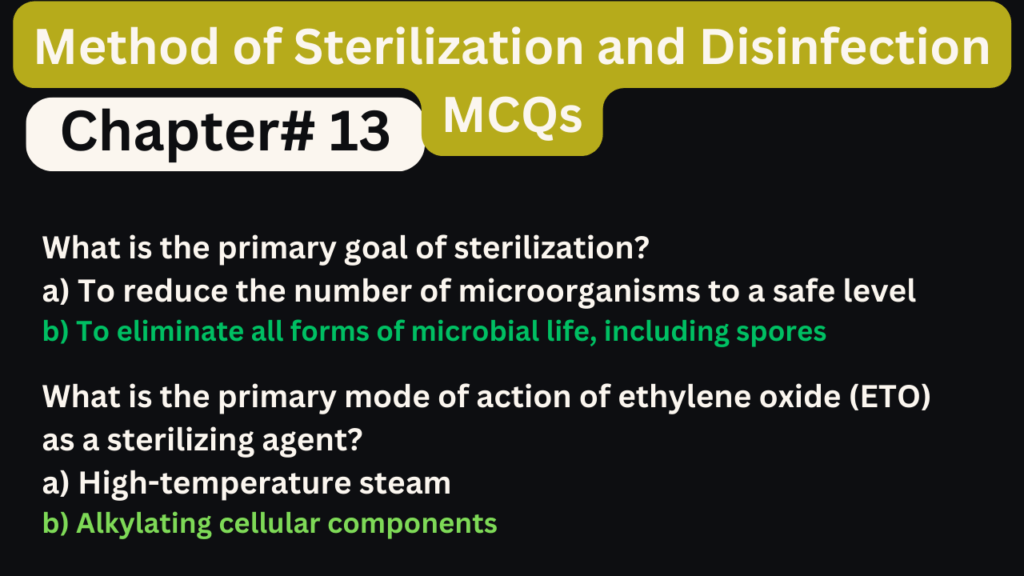Here are the important questions and answers from Chapter 13 (Method of disinfection are mcq ), sterilization and disinfection methods microbiology.

- What is the primary goal of sterilization?
a) To reduce the number of microorganisms to a safe level
b) To eliminate all forms of microbial life, including spores
c) To disinfect surfaces and equipment
d) To prevent the growth of bacteria - Which method of sterilization involves the use of high-pressure steam to kill microorganisms?
a) Autoclaving
b) Filtration
c) Boiling
d) Pasteurization - What is the primary mode of action of ethylene oxide (ETO) as a sterilizing agent?
a) High-temperature steam
b) Alkylating cellular components
c) Oxidizing cellular proteins
d) Filtration of microorganisms - Which of the following is a chemical disinfectant commonly used for disinfection of surfaces in healthcare settings?
a) Filtration
b) Boiling
c) Hydrogen peroxide
d) Autoclaving - What is the primary advantage of using ultraviolet (UV) radiation for disinfection?
a) It is effective in killing bacterial spores
b) It is non-toxic to humans
c) It requires high temperatures
d) It is ineffective against viruses - Which method of disinfection involves the removal of microorganisms by passing a liquid or gas through a filter with tiny pores?
a) Autoclaving
b) Pasteurization
c) Filtration
d) Ethylene oxide sterilization
- What is the purpose of using chemical disinfectants like chlorine and iodine?
a) To eliminate all forms of microbial life
b) To reduce the number of microorganisms to a safe level
c) To remove dirt and debris from surfaces
d) To enhance the growth of beneficial microorganisms - Which method of disinfection is commonly used for disinfecting drinking water and swimming pool water?
a) Filtration
b) Ultraviolet (UV) radiation
c) Chlorination
d) Autoclaving
- Which of the following methods of sterilization is NOT suitable for heat-sensitive materials?
a) Autoclaving
b) Dry heat sterilization
c) Ethylene oxide (ETO) sterilization
d) Gamma radiation - What is the primary advantage of using gamma radiation for sterilization?
a) It is inexpensive
b) It can be used for heat-sensitive materials
c) It requires minimal exposure time
d) It leaves a residue on sterilized items - Which chemical disinfectant is often used for skin antisepsis before medical procedures?
a) Iodine
b) Bleach (sodium hypochlorite)
c) Hydrogen peroxide
d) Ethanol - What is the primary mechanism of action of hydrogen peroxide as a disinfectant?
a) Alkylating cellular components
b) Oxidizing cellular proteins and enzymes
c) Heating microbial cells
d) Removing microorganisms by filtration - Which of the following is a limitation of using UV-C radiation for disinfection?
a) It is effective against bacterial spores
b) It requires minimal contact time
c) It is ineffective in air purification
d) It does not penetrate surfaces or materials - What is the primary purpose of pasteurization in the food industry?
a) To sterilize food products
b) To extend the shelf life of food
c) To improve the taste of food
d) To remove all microorganisms from food - Which sterilization method relies on the use of high-frequency sound waves to disrupt and kill microorganisms?
a) Autoclaving
b) Ultrasonication
c) Filtration
d) Dry heat sterilization - What is the primary purpose of filtration as a method of disinfection?
a) To eliminate bacterial spores
b) To remove dirt and debris from liquids
c) To expose microorganisms to high temperatures
d) To irradiate microorganisms with UV light Answer: b) To remove dirt and debris from liquids - Which of the following is a drawback of using ethylene oxide (ETO) for sterilization?
a) It is highly flammable
b) It leaves a residue on sterilized items
c) It requires high temperatures
d) It is ineffective against bacteria Answer: a) It is highly flammable - Which method of disinfection involves the use of chemicals or detergents to remove dirt and organic material from surfaces before applying a disinfectant?
a) Dry heat sterilization
b) Precleaning
c) Ethylene oxide (ETO) sterilization
d) Gamma radiation Answer: b) Precleaning - What is the primary limitation of using dry heat sterilization compared to moist heat methods like autoclaving?
a) It requires longer exposure times
b) It cannot penetrate materials effectively
c) It is less energy-efficient
d) It is not suitable for heat-sensitive materials Answer: b) It cannot penetrate materials effectively - Which disinfection method is often used for decontaminating laboratory equipment like pipettes and glassware?
a) Autoclaving
b) Pasteurization
c) Chemical disinfection
d) Ultraviolet (UV) radiation Answer: c) Chemical disinfection - Which method of disinfection primarily relies on the use of high temperatures to kill or inactivate microorganisms?
a) Chemical disinfection
b) Physical disinfection
c) Ultraviolet (UV) radiation
d) Filtration Answer: b) Physical disinfection - Which of the following is NOT a commonly used chemical disinfectant in microbiology?
a) Chlorine
b) Ethanol
c) Hydrogen peroxide
d) Glassware Answer: d) Glassware - What is the primary mechanism of action of chemical disinfectants like chlorine and iodine?
a) Mechanical removal of microorganisms
b) Altering the pH of the environment
c) Disrupting the cell membrane or proteins
d) Providing nutrients for microorganisms Answer: c) Disrupting the cell membrane or proteins - Which of the following is a method of disinfection commonly used in water treatment to kill or inactivate microorganisms?
a) Autoclaving
b) Pasteurization
c) Filtration
d) Incineration Answer: b) Pasteurization - Ultraviolet (UV) radiation is effective in disinfection primarily by:
a) Causing mutations in microbial DNA
b) Breaking down cell walls
c) Heating the microbial cells
d) Providing nutrients to the microorganisms Answer: a) Causing mutations in microbial DNA